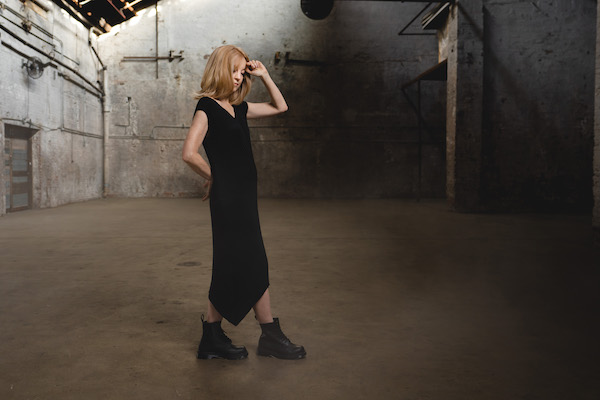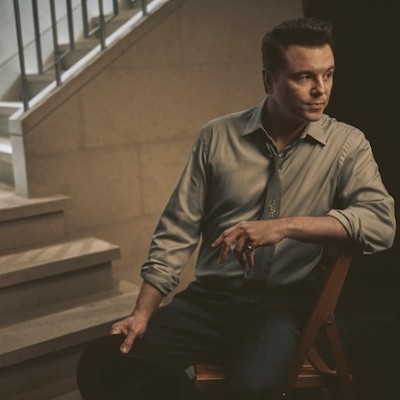Dec 9, 2025 12:28 PM
In Memoriam: Gordon Goodwin, 1954–2025
Gordon Goodwin, an award-winning saxophonist, pianist, bandleader, composer and arranger, died Dec. 8 in Los Angeles.…

Maria Schneider’s new release is a double album titled Data Lords.
(Photo: Briene Lermitte)Electric guitarist Ben Monder, who came onboard during the early-’90s recording sessions for Evanescence, provides many of the shimmering, distorted aural textures that characterize the first disc of Data Lords. He stressed the importance of taking part in the creative process and letting Schneider’s music develop organically, over time, with each performance or rehearsal.
“The first few times you play something, you have your nose in the music and you’re not necessarily hearing the big picture,” Monder said. “You’re not necessarily aware of how phrases work within the structure. But after reaching a certain critical mass of familiarity, it starts to flow out of you.”
Schneider encourages band members to take liberties with their parts and “be themselves” during solos. For Data Lords, she reached out to many of them personally in a spirit of collaboration and experimentation.
McCaslin recalled the numerous conversations that took place among himself, Schneider and other band members while preparing “CQ CQ, Is Anybody There?” During his solo, chord changes fall by the wayside as the rhythm section transitions to a free aesthetic.
“There was a lot of experimentation with, ‘What should that free thing look like?’” McCaslin said. “We talked about making it not sound like what we would normally do if it was free. We didn’t want to sound like four guys playing free in a jazz club in New York City. Maria wanted it to be more evocative and mysterious.”
Trumpeter Mike Rodriguez had productive conversations with Schneider regarding how to approach his solo on “Data Lords.” “She didn’t want a real jazzy kind of swinging solo,” he said. “It doesn’t call for that—more like shapes and sounds. So, I started to think more about texture. Then she asked me if I had any interest in working with electronic effects, and I was totally open to it. I was able to mess around with a pedal rack and use that on the recording.”
Band accordionist Gary Versace noted the high level of empathy among members of the ensemble. “People automatically change their role on the fly to fit with whatever’s going on,” he said. “It keeps it spontaneous. We find a path as a piece evolves. It’s a wonderful way of including all our individual voices into the process of composing. That’s the beauty of her music—she is so open about what happens.”
Pianist Frank Kimbrough, who’s been in the group since 1993, credited its success and longevity to a combination of Schneider’s strong leadership and an undeniable spirit of group camaraderie. “She’s smart, she’s honest and she treats the cats well,” he said. “That’s the thing about this band: It’s a great collection of human beings.”
Prior to the coronavirus pandemic, Schneider had intended to work on a commissioned piece for the New York Philharmonic. But with that plan temporarily on hold, and no current opportunities to tour in support of Data Lords, she remains uncertain about her plans for the future.
“I think I’ll just start writing and see what comes,” Schneider said. “I never set out to write about something. It’s whatever comes up. I just start writing and then all of a sudden, I have four or five pieces. And I look at them and I say, ‘Where did that come from?’
“It’s almost like the music is some sort of psychoanalysis: You look at your behavior or your dreams and you say, ‘What does that mean?’ And then it tells you something about yourself. In a way, my music is like dreams. And then I look at them and suddenly realize, ‘Oh, I guess I’ve got a problem with Google.’” DB
This story originally was published in the September 2020 issue of DownBeat. Subscribe here.

Goodwin was one of the most acclaimed, successful and influential jazz musicians of his generation.
Dec 9, 2025 12:28 PM
Gordon Goodwin, an award-winning saxophonist, pianist, bandleader, composer and arranger, died Dec. 8 in Los Angeles.…

Flea has returned to his first instrument — the trumpet — and assembled a dream band of jazz musicians to record a new album.
Dec 2, 2025 2:01 AM
After a nearly five-decade career as one of his generation’s defining rock bassists, Flea has returned to his first…

“It’s a pleasure and an honor to interpret the music of Oscar Peterson in his native city,” said Jim Doxas in regard to celebrating the Canadian legend. “He traveled the world, but never forgot Montreal.”
Nov 18, 2025 12:16 PM
In the pantheon of jazz luminaries, few shine as brightly, or swing as hard, as Oscar Peterson. A century ago, a…

Dec 11, 2025 11:00 AM
DownBeat presents a complete list of the 4-, 4½- and 5-star albums from 2025 in one convenient package. It’s a great…

Seth MacFarlane takes a turn from his television and film career to sing arrangements made for Frank Sinatra, but never recorded.
Nov 18, 2025 12:04 PM
“I’m not gonna lie to you — I don’t know why I thought this was about The Naked Gun, but I’m happy it’s…